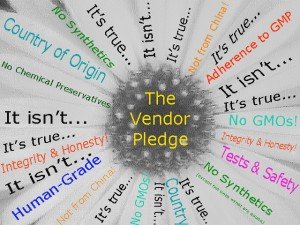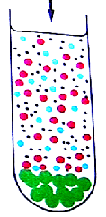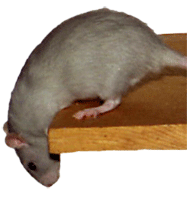1. Exaggeration of the overall quality of product:
 Terms such as ‘premium,’ ‘natural,’ ‘holistic,’ ‘healthy,’ and ‘natural’ are sometimes used to describe pet foods of extremely poor quality. So, why do some manufacturers use these terms misleadingly. Well, first and foremost, because they can. But more commonly, these terms may be employed simply because they might omit the most toxic chemical preservatives. They still may use low quality (e.g., ‘feed-grade,’ ‘meat meals’) or unhealthy ingredients (e.g., refined, overly processed ingredients or processing methods) and synthetic additives which are associated with several health risks and nutrient depletion. Due to the lack of regulation and legal definition of these terms, many pet food companies use these terms freely and without constraint to increase their profits. Don”t feed any Frankenfoods to your pet.
Terms such as ‘premium,’ ‘natural,’ ‘holistic,’ ‘healthy,’ and ‘natural’ are sometimes used to describe pet foods of extremely poor quality. So, why do some manufacturers use these terms misleadingly. Well, first and foremost, because they can. But more commonly, these terms may be employed simply because they might omit the most toxic chemical preservatives. They still may use low quality (e.g., ‘feed-grade,’ ‘meat meals’) or unhealthy ingredients (e.g., refined, overly processed ingredients or processing methods) and synthetic additives which are associated with several health risks and nutrient depletion. Due to the lack of regulation and legal definition of these terms, many pet food companies use these terms freely and without constraint to increase their profits. Don”t feed any Frankenfoods to your pet.
(I apologize to McCoy, who is featured here in his Frankenstein Monster costume, but this one was just too tempting!)
2. Abuse of the term ‘organic’:
The only organic claim in the pet food industry that must, by law, be valid and verified by an unbiased third party is ‘USDA certified organic.’ Claims of ‘organic’ alone are not currently regulated or subject to oversight, and this fact makes it perfectly legal for pet food companies to market their conventional products as ‘organic.’ Many pet food manufacturers abuse the general lack of oversight, regulation, and enforcement, as well as the all-too-common confusion over precisely what the various claims of organic being made actually mean. Unfortunately, this situation has important implications not only for your pet’s health and your pocket book, but also the honest companies that go the extra distance to create food products that are healthier for your pet and better for the environment.
If you don’t see the USDA organic seal and the name of an organic certifying agency on a product’s label, quite often you’ll be buying something that isn’t really organic, i.e., there isn’t a USDA certification to verify its legitimacy. A little known fact that’s important for careful consumers to know: one can also request an organic certificate from the particular company in question. Genuine USDA-certified organic producers must have such certificates on hand and available for every product that is marketed as ‘certified organic.’ Even if a company states that they use 100% organic grains, for example, without an organic certificate to back up this claim, it simply comes down to trusting the word of that manufacturer alone. And, believe me, trust alone isn’t good enough in a rabidly competitive marketplace.
Something else that you should be aware of: most organic consumer associations do not discriminate, in their buying guides, websites, or elsewhere, between companies with USDA organic certification and those that merely proclaim organic status on their labels and in their promotional materials (including websites. So, it is critically important that consumers take a big drink from the educational ‘firehose.’ The easiest way to obtain clear and unbiased information is to check out the USDA website or to simply call or write to one of the USDA-accredited organic certifying agencies (e.g., Oregon Tilth, Quality Assurance International or QAI for short).
Unlike certified organic pet food products, pet foods that carry stand-alone organic claims (i.e., no USDA certification) may contain perhaps a small number (perhaps just one) of organic ingredients and, say, a dozen or more conventional ingredients. Why would a professed organic pet food manufacturer use some high quality organic ingredients mixed in with conventional ingredients? Well, quite simply, this is a half-baked way to legitimize a claim of organic status, and, at the same time, save a lot of money! You should be aware that legitimate, USDA certified organic pet foods cannot use conventional ingredients when organic versions are available, and for the most part, they are. There are a few conventional-grade (i.e., non-certified organic) ingredients that, by necessity, are allowed because organic varieties are simply not available yet. These include fish and certain additives with preservative properties, such as calcium carbonate.
If a pet food company tells you there is such a thing as a certified organic ‘byproduct,’ quite simply they’re selling you a line. Organic certification simply does not allow the use of ingredients which cannot be sourced to their origins. Period. End of story. If a manufacturer declares their byproducts are healthful parts such as liver, heart, gizzards, etc. why wouldn”t these manufacturers name these organ meats openly instead of using this strange, indefinable word ”byproduct”?
3. Use of the terms ‘USDA-approved facility’ or ‘USDA meat’:
These terms are applied in cases where human foods are manufactured in a food processing plant used expressly for production of human foods and that the meat referred to is fit for human consumption, respectively. Since the terms ‘USDA-approved facility’ and ‘USDA meat’ are reminiscent of ‘USDA organic,’ some companies may use these terms intentionally to elicit the association with USDA certified organic products. Some manufacturers may also deploy the terms ‘organic ingredients,’ ‘hormone-free,’ ‘antibiotic-free,’ and ‘GMO-free’ to strengthen this association. But take note that USDA certified organic products are by law—and through strict verification—free of antibiotics, hormones, or genetically modified organisms (GMOs).
4. Use of the OTA seal:
The Organic Trade Association (OTA) is not a USDA-accredited organic certification agency. Like other trade associations, membership is based on the payment of a membership fee. Presentation of OTA membership, whether on a product label or website, does not mean that a given member uses organic ingredients in their pet foods. Since few consumers are aware of this, the OTA seal is often used to elicit the impression of a certification entity for unverified (i.e., non-certified) organic claims. With all due respect to the OTA, third parties may often carry their seal to legitimize a claim of true organic status. On the face of it, this does not reflect poorly on the OTA—they’re a legitimate trade association and don’t represent themselves as a certifier. Rather, it suggests that a number of companies out there may be using the OTA seal as a marketing tool, a tactic that is perfectly legal, but not necessarily demonstrative of a high ethical standard.
5. Claims of sustainability or of being ‘green’:
Some companies may purchase packaging that is made from recycled paper and market themselves as green on this basis alone. What they don’t explain, of course, is that the packaging was imported from far-flung countries such as China, and the energy and resources used to transport it were prodigious—and anything but green! Many companies proudly display a ‘Coop America-approved’ seal, implying a green ethos. Now, unquestionably, Coop America is an organization that attempts to promote green values. But some of the companies that carry this insignia are not necessarily truly green. The Coop America application process is done via paper application or by phone; no substantiating documentation for green claims concerning, for example, sourcing of materials, fair wages, or organic ingredient claims is required. Certainly, the examination of application materials involves nowhere near the scrutiny of the process for certifying organic products such as pet foods. As is the case with the Organic Trade Association, ‘Coop America’ members pay an annual fee.
6. Claims of USA-sourced ingredients:
Such claims are often soft, but obviously quite useful, in these times of widespread and disastrous pet food recalls. Be aware that only USDA certified organic ingredients can be sourced to specific farms, whether in Montana or China. The USDA-accredited certifying agency has access to the names and locations of all ingredient suppliers and therefore can trace the source of any organic ingredient. The records that certified organic manufacturers must make available to these certifying agencies necessarily demonstrate that any organic, fair trade, or human-grade claims can be substantiated. Here’s a counter-example: if a US company states that it uses organic kelp that is harvested in the US, just walk away: currently, there is no source for certified organic US-grown kelp. If a company makes this claim, you can be pretty sure that their other claims are similarly exaggerated or just plain bogus.
7. Claims that the conventional ingredients used are as good as organic:
Hmmm . . . an interesting claim, but how could any company possibly substantiate it? If a company can demonstrate that the ingredients in its products have not been treated with toxic pesticides, herbicides, fertilizers, antibiotics, hormones, and that they are not genetically engineered, well they might have a case. But any or all of these treatments and conditions might render the ingredients in question inferior in quality compared with certified organic varieties. So, if a company cannot provide any evidence to back up a claim of equivalence in quality of conventional ingredients and organic counterparts—and right now, without USDA organic certification, no company can—then that claim is simply worthless.
8. Claims that pet foods would be raw or raw dehydrated:
Sometimes apparently well-respected pet food manufacturers “forget” to mention to their customers that they dehydrate ingredients that have been previously cooked. If there is no explicit statement about how each ingredient was processed before dehydration, ask the manufacturer. Although the manufacturer can theoretically still serve you an outright lie as an answer, this at least alerts them to the fact that pet guardians are more attentive than they’ve hoped! Unfortunately, these ‘minor’ processing details and claims are also not enforced by any government or unbiased third party agency - EXCEPT if you are dealing with a certified organic pet food where an organic certifying agency inspects each processing detail for each ingredient used. In brief, organic certification assures that ‘raw’ or ‘dehydrated raw’ claims and promises made on the pet food package are true. Without organic certification these claims are unsubstantiated.
Unfortunately, in our modern, highly competitive world, compacts based solely on trust do not mean much any more.
Naked greed and legal loopholes encourage very bad behavior. So, don’t fall prey to empty claims. Inform yourself before buying that pet food in the pretty packaging with high-flying claims. Where claims that sound great can’t be verified, at best, you’re not getting what you think you’re paying for, and at worst, your pet is being short-changed nutritionally and otherwise. Be a careful, educated, and vigilant shopper: your pet will thank you. And, not to be forgotten, the ethical manufacturers out there that try to do the right thing will survive another day to create products that are good for your pet and the planet we all share!
 Posted by Heidi Junger, PhD under
Posted by Heidi Junger, PhD under  Organic Pet Food Standards, Regulations
Organic Pet Food Standards, Regulations  Comments Off
Comments Off

 Almost all of the so-called ‘balanced’ or ‘complete’ pet foods are supplemented with isolated nutrients (particularly vitamins, amino acids, and minerals) to achieve measured levels of nutrients mandated for particular species by the National Research Council (NRC). These levels are required if a given manufacturer wishes to display the coveted “Meets AAFCO”s standards” (Association of American Feed Control Officials) claim on marketing materials and product labels.
Almost all of the so-called ‘balanced’ or ‘complete’ pet foods are supplemented with isolated nutrients (particularly vitamins, amino acids, and minerals) to achieve measured levels of nutrients mandated for particular species by the National Research Council (NRC). These levels are required if a given manufacturer wishes to display the coveted “Meets AAFCO”s standards” (Association of American Feed Control Officials) claim on marketing materials and product labels. So what’s a good alternative to the ubiquitous artificially supplemented ‘complete’ and ‘balanced’ diets?
So what’s a good alternative to the ubiquitous artificially supplemented ‘complete’ and ‘balanced’ diets?
 Terms such as ‘premium,’ ‘natural,’ ‘holistic,’ ‘healthy,’ and ‘natural’ are sometimes used to describe pet foods of extremely poor quality. So, why do some manufacturers use these terms misleadingly. Well, first and foremost, because they can. But more commonly, these terms may be employed simply because they might omit the most toxic chemical preservatives. They still may use low quality (e.g., ‘feed-grade,’ ‘meat meals’) or unhealthy ingredients (e.g., refined, overly processed ingredients or processing methods) and synthetic additives which are associated with several health risks and nutrient depletion. Due to the lack of regulation and legal definition of these terms, many pet food companies use these terms freely and without constraint to increase their profits. Don”t feed any Frankenfoods to your pet.
Terms such as ‘premium,’ ‘natural,’ ‘holistic,’ ‘healthy,’ and ‘natural’ are sometimes used to describe pet foods of extremely poor quality. So, why do some manufacturers use these terms misleadingly. Well, first and foremost, because they can. But more commonly, these terms may be employed simply because they might omit the most toxic chemical preservatives. They still may use low quality (e.g., ‘feed-grade,’ ‘meat meals’) or unhealthy ingredients (e.g., refined, overly processed ingredients or processing methods) and synthetic additives which are associated with several health risks and nutrient depletion. Due to the lack of regulation and legal definition of these terms, many pet food companies use these terms freely and without constraint to increase their profits. Don”t feed any Frankenfoods to your pet. 